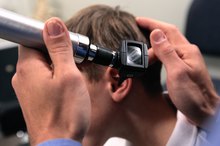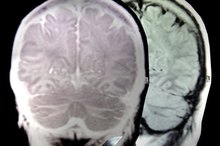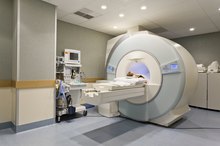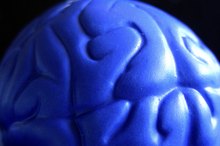Parts of the Brain Used While Driving
Driving requires a person to integrate information from multiple visual and auditory sources. Visual information that needs to be processed includes activity on the road, your mirrors and the instrument display. Similarly, auditory information includes sounds made by your car, other cars and pedestrians. The driver also needs to get information about the stability of the vehicle on the road and combine numerous motor activities such as steering, braking and acceleration. With the brain focusing on all those tasks at once, it comes as no wonder that several areas of the brain are involved in this process.
Frontal Lobe
Have you ever driven on “autopilot” or without any memory of the trip itself? If so, you probably have lots of experience driving and really do not need to use your frontal lobe all that much for driving. The frontal lobe is activated whenever potential danger lurks and analyzes the best response to the situation. It helps in areas such as planning routes and controlling memorized body movement. The dorsal lateral prefrontal cortex, a part of the frontal cortex, plays an important part in judgments and decision-making. Dr. Gian Beeli showed in a study published in Behavioral Brain Functions in August 2008 that this area reaches its full maturity when a person is about 20 years old. This slow maturity rate might explain some of the needless risks teenagers take while driving.
- Have you ever driven on “autopilot” or without any memory of the trip itself?
- Dr. Gian Beeli showed in a study published in Behavioral Brain Functions in August 2008 that this area reaches its full maturity when a person is about 20 years old.
Parietal Lobe
Parts of the Brain Involved With Hearing
Learn More
The parietal lobe works hard while you drive, because it is responsible for integrating information from all the senses. This area knows how to manipulate objects and is responsible for visuo-spatial perception. The parietal lobe is activated when a person switches his attention from one location to another. Dr. Marcel A. Just and colleagues at Carnegie Mellon University showed in a study published in the February 1998 edition of the journal Brain Research that just listening to someone talking reduces the activity of the parietal lobe associated with spatial processing by 37 percent as well as dropping their driving performance 24. That means even if you do not hold a phone while driving, you are still at an increased risk of a collision.
- The parietal lobe works hard while you drive, because it is responsible for integrating information from all the senses.
- Dr. Marcel A.
- Just and colleagues at Carnegie Mellon University showed in a study published in the February 1998 edition of the journal Brain Research that just listening to someone talking reduces the activity of the parietal lobe associated with spatial processing by 37 percent as well as dropping their driving performance 2.
Occipital and Temporal Lobes
The occipital lobe is the home of a visual cortex. Naturally, this area is crucial for driving. It is responsible for interpreting the visual information that the driver receives. The auditory cortex is in the temporal lobe. This area interprets sounds heard by the driver, and, together with the frontal lobe, makes decisions about the significance of those sounds.
- The occipital lobe is the home of a visual cortex.
- This area interprets sounds heard by the driver, and, together with the frontal lobe, makes decisions about the significance of those sounds.
Cerebellum and Other Areas Outside Cortex
Left Frontoparietal Functions in the Brain
Learn More
The cerebellum has many important tasks during driving. It coordinates voluntary muscle movements and maintains balance. It activates when the driver prepares to do something, or makes rapid decisions. Many other areas also get active while driving. According to Drs. Hugo J. Spiers and Eleanor A. Maguire, these include the putamen, the pallidum, the caudate and the hippocampus. Their findings were published in the May 2007 edition of the journal Neuroimage.
- The cerebellum has many important tasks during driving.
- It activates when the driver prepares to do something, or makes rapid decisions.
Related Articles
References
- Brain Research: A Decrease in Brain Activation Associated with Driving When Listening to Someone Speak
- Behavior and Brain Functions: Brain Stimulation Modulates Driving Behavior
- The Heartford: Driving and the Brain
- Neuroimage: Neural Substrates of Driving Behaviour
- Boly M, Massimini M, Tsuchiya N, Postle BR, Koch C, Tononi G. Are the Neural Correlates of Consciousness in the Front or in the Back of the Cerebral Cortex? Clinical and Neuroimaging Evidence. J Neurosci. 2017;37(40):9603-9613.
- Jawabri KH.Physiology, Cerebral Cortex Functions.StatPearls [Internet]. Treasure Island (FL): StatPearls Publishing; 2019-. Accessed June 22, 2019
- Hurley RA, Flashman LA, Chow TW, Taber KH. The brainstem: anatomy, assessment, and clinical syndromes. J Neuropsychiatry Clin Neurosci. 2010;22(1):iv, 1-7. doi: 10.1176/jnp.2010.22.1.iv
- Wagner MJ, Kim TH, Savall J, Schnitzer MJ, Luo L. Cerebellar granule cells encode the expectation of reward. Nature. 2017;544(7648):96-100. doi: 10.1038/nature21726
- Fama R, Sullivan EV. Thalamic structures and associated cognitive functions: Relations with age and aging. Neurosci Biobehav Rev. 2015;54:29-37. doi: 10.1016/j.neubiorev.2015.03.008
- Biran J, Tahor M, Wircer E, Levkowitz G. Role of developmental factors in hypothalamic function. Front Neuroanat. 2015;9:47. doi: 10.3389/fnana.2015.00047
- Anand KS, Dhikav V. Hippocampus in health and disease: An overview. Ann Indian Acad Neurol. 2012;15(4):239-46. doi: 10.4103/0972-2327.104323
- Lanciego JL, Luquin N, Obeso JA. Functional neuroanatomy of the basal ganglia. Cold Spring Harb Perspect Med. 2012;2(12):a009621. doi: 10.1101/cshperspect.a009621
- Carter, R. The Human Brain Book. New York: Penguin; 2014.
- Kalat, JW. Biological Psychology. Boston, MA: Cengage Learning; 2016.
Writer Bio
Marie Cheour had her first article published in 1995, and she has since published more than 40 articles in peer-reviewed publications such as "Nature" and "Nature Neuroscience." She has worked as a college professor in Europe and in the United States. Cheour has a Ph.D. in cognitive psychology from the University of Helsinki.








